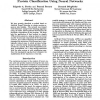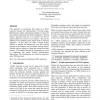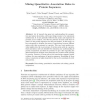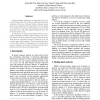BMCBI
2010
14 years 16 days ago
2010
Background: The classification of protein sequences using string algorithms provides valuable insights for protein function prediction. Several methods, based on a variety of diff...
BMCBI
2010
14 years 16 days ago
2010
Background: This paper deals with the preprocessing of protein sequences for supervised classification. Motif extraction is one way to address that task. It has been largely used ...
ISMB
1993
14 years 1 months ago
1993
Wehave recently described a method based on Artificial Neural Networksto cluster protein sequences into families. The network was trained with Kohonen’s unsupervised-learning al...
APVIS
2004
14 years 1 months ago
2004
1 The sequence of nucleotides that makes up a DNA molecule encodes the characteristics of living things. Bioinformatics offers sophisticated methods to search for and compare nucl...
BIRD
2008
Springer
14 years 2 months ago
2008
Springer
The inverse protein folding problem is that of designing an amino acid sequence which has a prescribed native protein fold. This problem arises in drug design where a particular st...
AUSDM
2006
Springer
14 years 4 months ago
2006
Springer
Abstract. Lot of research has gone into understanding the composition and nature of proteins, still many things remain to be understood satisfactorily. It is now generally believed...
AINA
2006
IEEE
14 years 4 months ago
2006
IEEE
HMMer is a widely used tool for protein sequence homology detection, as well as functional annotation of homologous protein sequences, and protein family classification. The HMMer...
DMKD
2003
ACM
14 years 5 months ago
2003
ACM
Given a known protein sequence, predicting its secondary structure can help understand its three-dimensional (tertiary) structure, i.e., the folding. In this paper, we present an ...
CSB
2003
IEEE
14 years 5 months ago
2003
IEEE
Protein sequence analysis is an important tool to decode the logic of life. One of the most important similarity measures in this area is the edit distance between amino acids of ...
PRICAI
2004
Springer
14 years 5 months ago
2004
Springer
Abstract. Infection by high-risk human papillomaviruses (HPVs) is associated with the development of cervical cancers. Classification of risk types is important to understand the ...




